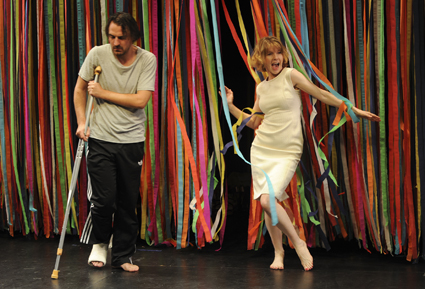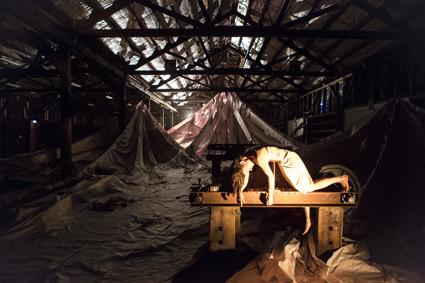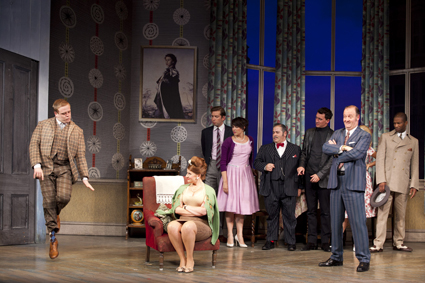appropriations & approximations
keith gallasch: sydney performance

Ewen Leslie, Jacqueline McKenzie, Cat on a Hot Tin Roof
photo Heidrun Löhr
Ewen Leslie, Jacqueline McKenzie, Cat on a Hot Tin Roof
FOUR PRODUCTIONS, FOUR KINDS OF ENGAGEMENT—BELVOIR’S OVER-HEATED AUSTRALIAN ASSIMILATION OF CAT ON A HOT TIN ROOF, THE LIVING ROOM THEATRE’S OVERWROUGHT APPROPRIATION OF CONTEMPORARY PERFORMANCE, THE FIRST GARDEN’S TOO, TOO DIDACTIC RENDERING OF A LIFE, AND THE NATIONAL THEATRE OF BRITAIN’S CLEVER IMAGINING OF A COMMEDIA DELL’ARTE-INFUSED 60S BRITISH FARCE. SUCH ARE THE THINGS THAT THEATRE IS MADE OF.
belvoir, cat on a hot tin roof
There was pretty much unanimity among Sydney reviewers that Belvoir’s production of Tennessee Williams’ Cat on Hot Tin Roof (1955) was flawed, not least because of the directorial decision to render it in a tonally neutral Australian English. Bye bye Williams’ musicality, save for Big Mama, Lynette Curran’s marked oz accent delivering something of the much-missed poetry. In Jacqueline Mackenzie’s Maggie the loss of Williams’ lyricism meant that she was all “on a hot tin roof,” embodying a stunning hyperactivity born of emotional and sexual starvation, but not at all sensual, sinuous or feline. Elizabeth Taylor in the film (1958) conveyed something of the toxic combination of sultry languor and outburst that was missing here, for all of Mackenzie’s otherwise finely nuanced performance.
The production is framed by a large curtain comprising brightly coloured strips, suggestive of celebration, through which entrances and exits can be made on a revolve which allows for characters, a piano and various pieces of furniture to come and go, and for scenes to merge seamlessly. The frame for the performance thus becomes circular, at one stage lined by Maggie’s shoe collection, at another sustaining the momentum of Maggie’s fruitless pursuit of the limping Brick (Ewen Leslie)—the husband wounded by the death of his dearest friend and near silenced by the inability to express his homosexuality.
Maggie’s self-belief and sense of theatricality are amplified from the opening with an extended focus on her dressing, making up and applying toe-nail polish all the while verbally pummelling the still Brick and at one point scissor locking him with her legs. Brick breaks Maggie’s flow with silence or a blunt counter-rhythm. The fraught relationship between Brick and his father, Big Daddy extends this counterpoint—at its best on the occasions when Marshall Napier (a late replacement for an ill Anthony Phelan), was free of the script, the pair realising a verbal dance of evasion and potential connection fuelled by Big Daddy’s needy desire (after a cancer scare) to communicate and Brick’s belief that it had never happened and never will. The dialogue is frequently about talk—the meaning and weight of words, ‘pity,’ ‘homo,’ ‘truth,’ ‘queer’ and especially ‘disgust’; about questions, the barrage aimed at the unresponsive Brick by Maggie and Big Daddy; and when talk fails—a crutch kicked away, furniture smashed, the curtain torn down (melodramatically underlined with screaming guitar).
The structure of Cat on a Hot Tin Roof poses a particular challenge of balance. Maggie is the driving force of the first third of the play with Brick a reticent, sulky presence. The conflict between Big Daddy and Brick, again a battle against refusal, is the play’s centre. This is followed by Maggie’s manipulative assertion of her husband’s rights—and then her own as she prepares, in this production, to fellate Brick. That the drama plays out more between a dying father and his son than between husband and wife (Maggie is a lesser psychological and stage presence in the latter half of the play) makes the ending feel unlikely and the relationship forever unresolved. Perhaps that’s as it should be. But we’re left in no doubt about Maggie’s strength and determination, if uncertain of Brick’s passive resolve. Despite critical reserve, the profound loss of the music of Williams’ Southern English and an absence of interpretive clarity (unusual for director Simon Stone), Belvoir’s volatile Cat on a Hot Tin Roof has apparently proved to be a popular success—a family saga with themes still quite contemporary and big issues—existential disgust, social prejudice and a sense of renewal with “a life in the place of death”—all writ large.
i love todd sampson

Gabrielle Quin, I Love Todd Sampson, The Living Room Theatre
photo Brett Boardman
Gabrielle Quin, I Love Todd Sampson, The Living Room Theatre
Pier 2/3, Walsh Bay is the expansive site for the Living Room Theatre’s I Love Todd Sampson—Voices of the Vulnerable, a large-scale multimedia installation through which the audience follow Laura (Gabrielle Quinn), a woman suffering a nervous breakdown, the result of abuse and the likely false belief that she is responsible for the death of a cellist. On a journey into deepening madness, Laura encounters her mother, people from her past, a would-be lover whom she consistently rejects and symbolic figures (a woman abseiling across the wharf’s timber walls while towing a resistant figure) in a variety of installations designed by members of local architectural firms. These vary from domestic (rooms within rooms) to surreal (a mountainous winterscape made of paper) and domestic-surreal (a stylish, seemingly off-balance kitchen, the setting for an unstable domestic scenario). Adding to the sense of unease created by changes of location and character mutations, is the voiceover provided by the actual Todd Sampson (CEO of Leo Burnett Australia, co-creator of the Earth Hour initiative and commentator on The Gruen Transfer and The Project). Laura aurally hallucinates him as her saviour, but when she fails to make him incarnate, and sexual, in a spooky (carefully designed) wreck of a building, she emotionally unravels. Finally, after being subjected to increasingly nightmarish scenarios (including a near hallucinatory vision—for the audience—of a rain shower sparkling into suspended motion), she collapses onto rusted machinery in an arctic waste and dies.
While to all appearances a contemporary performance work I Love Todd Sampson was burdened by heavy-handed acting, taxing longeurs and highly variable design quality, as well as by sundry performance clichés. The scale of Wharf 2/3 meant that text, either doggedly literal or numbingly opaque, wasn’t always audible. I Love Todd Sampson is a work of excess but not excess that yields wisdom. It has some structural and psychological kinship with Botho Strauss’ similarly discursive Gross und Klein, but Strauss’ vision is more consistently lateral and quite un-melodramatic; Lotte might be regarded as mad by those she encounters, but they themselves prove to be more dangerous. If I Love Todd Sampson is clearly the work of ambitious young artists defeated by the scale of their vision, they nonetheless warrant praise for realising it on such scale and for the rigour, if not subtlety, with which Gabrielle Quinn lives out Laura’s fatal madness.
one man, two guv’nors

One Man, Two Guv’nors, National Theatre of Great Britain
photo Lisa Tomasetti
One Man, Two Guv’nors, National Theatre of Great Britain
Other than to entertain, there appears to be no visible or palpable sense of higher purpose to Richard Bean’s One Man, Two Guv’nors, the international stage success rooted in the commedia dell’arte tradition (it’s based on Carlo Goldoni’s The Servant of Two Masters, 1746), transposed to early 1960s London and textured with postmodern flourishes that a 2013 audience knowingly applaud. Politically the play is light-on, most of its references to feminism and homosexuality are of the arch insult or the ‘nudge nudge, wink wink,’ variety, funny because they now appear so quaint, recalling a more repressed era, that of the risqué joke. At times, when murder is on the agenda or sadomasochism is hinted at, it’s as if One Man, Two Guv’nors will turn out to be a farce desultorily knocked out by the late Joe Orton, the comic genius of the 1960s British theatre, for a bit of spare cash. The show is laced with the broad humour of Benny Hill, the Carry On films, cross-dressing and a few touches the overtly satirical new wave of British comedy in the 60s.
If there is a higher purpose to One Man, Two Guvnors, it is manifest in the production’s celebration of commedia dell’arte, British comedy and above all theatrical virtuosity—expert timing, risk-taking physical dexterity (physical comedy director, Cal McCrystal), broad characterisations with memorably subtle touches, convincing singing, dancing and vaudevillian turns and the capacity to adopt the audience as confidante and transform them into the conned. Owain Arthur—the one man-two servants—embodies all these skills, realising Frances as not too bright but endowed with highly adaptive tunnel vision and the physical capacity to act on it, lurking, running, vaulting, crashing and spasming all too convincingly. The best reason for seeing One Man, Two Guvnors, even if the calculatedly thrusting direct address of the actors and the musical interludes can be wearying and the status quo holds, as ever, is to witness theatre history virtuosically recreated and reimagined.
the first garden
Olive Pink, like Daisy Bates, is one of those significant and eccentric female figures from Australian history who are resurrected to public attention from time to time (Tracks Dance produced Fierce, about Pink, in Darwin in 2001, RT45, p9) both for their relationship with and support of Aboriginal people, if much more contentiously so in the case of Bates.
Pink (1884-1975) was a botanical illustrator, anthropologist, environmentalist, an activist for the Warlpiri and Aranda people of Central Australia and the creator of an ecologically sound Australian garden in Alice Springs. The play by Christopher Raja and Natasha Raja (who plays Pink) is plainly and quite didactically constructed. The aged Pink at work on her garden is haunted by the over-protective Harold Southern she lost to World War I and who attempts to restrain her activism. Into this scenario come other figures including the amiable Warlpiri man who assists her, Johnny Tjampatjimpa, played by Eshua Bolton, who also doubles as a hostile and destructive Tasman, on the run from the law and testing the limits of Pink’s compassion. Although Bolton imparts a degree of subtlety to his performance, Raja as Pink is one-dimensional, restrained by a heavily made-up, mask-like demeanour and a rigid physical interpretation of ageing. Like Scott Fraser, who plays Southern, her vocal delivery is one-note, presumably to meet the exigencies of outdoor performance. Slowly paced and too inclined to exposition and broad characterisation, The First Garden is to be admired for its commitment to revealing the complexities of Olive Pink’s life and the richness of her vision and is pleasantly staged in Sydney’s Botanic Gardens with music live from Christopher Brocklebank, Hugh Brocklebank and Bill Peechy.
Belvoir, Cat on a Hot Tin Roof, writer Tennessee Williams, director Simon Stone, performers Ewen Leslie, Jacqueline McKenzie, Marshall Napier, Lynette Curran, design Robert Cousins, costumes Alice Babidge, lighting Damien Cooper, composer, sound designer Stefan Gregory, Belvoir from Feb 20; The Living Room Theatre, animateur Michelle St Anne, performers Imogen Cranna, Alan Flower, Lanneke Jones, Michelle St Anne, Ling-Hsueh Tang, Gabrielle Quinn, Carol Divjak, architectural producer Andy Macdonald, creative advisor Chrissie Koltai, installation artist Michaela Gleave, media artist Imogen Cranna, production designer Joel West, composer, sound designer Lawrence English, composer, pianist Alister Spence, cellist Mary Rapp, Wharf 2/3, Feb 28-March 10; National Theatre of Great Britain, One Man, Two Guv’nors, writer Richard Bean, director Nicholas Hytner, physical comedy director Cal McCrystal, choreographer Adam Penford, lighting Mark Henderson, music Grant Olding, design Mark Thompson, Sydney Theatre, from April 2; The First Garden, writers Christopher Raja, Natasha Raja, director Steve Kidd, performers [see review], co-producers Benjamin Convery and the Olive Pink Botanic Garden, Alice Springs; Royal Botanical Gardens, Sydney, March 8-17
RealTime issue #114 April-May 2013 pg. 42






